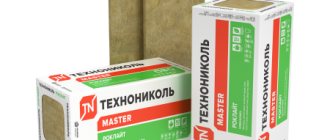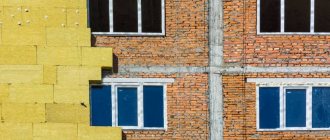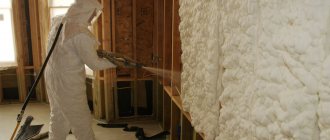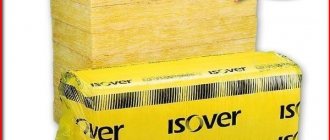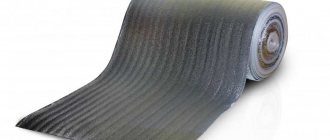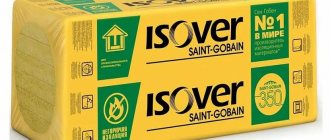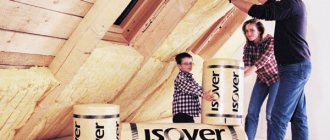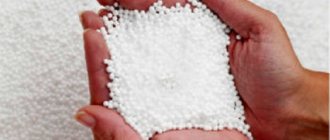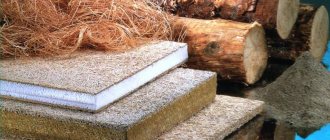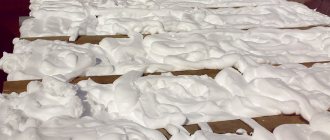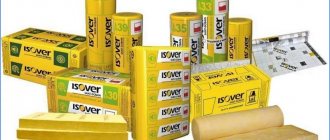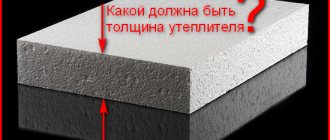The article will discuss what isover insulation is, how it is produced, what technical characteristics it has, what disadvantages the products of the French concern “Saint-Gobain” have, what types of presented material are most popular in our domestic market. Photos and videos will reveal the nuances of installing slabs and rolls.
Packed isover slabs Source emupauto.ru
How it is made
So, what is Isover insulation? The characteristics of any insulating material depend primarily on how accurately the required technologies are followed during its production. Isover insulation is manufactured as follows:
- Quartz sand, cullet, limestone, soda ash and other minerals are thoroughly mixed in advance.
The resulting mixture melts at a temperature of 1300 degrees. until a homogeneous fluid plastic mass is obtained. In a special installation, this liquid glass is fed from a great height into a bowl rotating at high speed, the walls of which have small holes. Under the influence of centrifugal force, the hot mass is squeezed out in the form of long thin threads. The fibers are mixed with yellow polymer glue. The resulting sticky mass is fed into a special oven, where it is rolled between steel shafts and blown with hot air. As a result, the glue sets and the layer itself is leveled. The finished glass wool is fed into circulation saws to be cut into slabs of the required size.
Material Specifications
With an optimal price/quality ratio, thermal insulation has the following technical characteristics:
It should be clarified that these are average indicators. Insulation is available in a wide range, so density and thermal conductivity may vary.
| № | Name | Dimensions | Thermal conductivity | Weight | Volume (pack/m2/m3) |
| 1 | Isobox Extralight | 1200mm*600mm*50mm | 0.038 W/(m*K) | ~ 4.8 kg/pack | 8 pcs/pack 5.76 m2/0.288 m3 |
| 2 | Isover Classic Plus | 1170mm*610mm*50mm | 0.039 W/(m*K) | ~ 6.5 kg/pack | 14 pcs/pack 10 m2/0.5 m3 |
| 3 | Izover Classic TWIN-50 | 6150mm*1220mm*50mm | 0.041 W/(m*K) | ~10 kg/pack | 2 pcs/pack 15 m2/0.75 m3 |
| 4 | Izover Frame P-34 | 1170mm*619mm*50mm | 0.034 W/(m*K) | ~7.61 kg/pack | 16 pcs/pack 11.42 m2/0.571 m3 |
Installation features
The frame for Izover can be assembled from either a wooden plank or a metal profile. The distance between the individual elements of the sheathing should be slightly less than the width of the insulation boards. This allows you to install them by surprise.
Of course, “Izover”, the technical characteristics of which we have described, when used as a heat or sound insulator, must be protected from moisture. In order to prevent it from getting wet, steam and waterproofing films are used. When assembling a pie of walls or roofing, in this case a certain order of installation of materials is observed. The vapor barrier is installed on the interior side. Due to temperature differences, the humidity in rooms and attics is usually higher than outside. Therefore, condensation forms on the walls and ceiling. Using a vapor barrier prevents it from getting on the insulation. A waterproofing film is installed outside. It protects Izover from getting wet during rain or melting snow.
Additional fasteners when installing slabs, as already mentioned, are not used. They are only necessary when installing the material on the ceiling. In order to completely prevent their loss, in this case special dowels called “fungi” are used.
Since the material is capable, albeit in small quantities, of releasing substances harmful to human health, when installing it from inside the premises, you should carefully monitor the tightness of all finishing seams.
Description and Application
The presented material has many advantages and disadvantages of mineral wool. And this is not surprising, since their properties are quite similar. It is produced in the form of slabs, which can be either rigid or semi-rigid. There is also the opportunity to buy Izover in the form of rolls and mats. They are used in the arrangement of the roof and facades of the house, ceilings, walls and floors.
Izover is based on glass fibers, the length of which reaches 100-150 microns and the thickness of 4-5 microns. It is these parameters that allow the Izover heat insulator to obtain high levels of elasticity and resistance to loads.
In the photo Izover insulation
Characteristics and scope
The material is produced in slabs and rolls and is characterized by high thermal efficiency, elasticity, density and light weight.
Refers to non-combustible materials. The main competitors in the mineral insulation market are Ursa, Izovol, Rockwool, Parok, Knauf. Isover mineral wool has a wide range of applications in general construction work. For industrial work, the Izover company produces insulation under the Isotek brand.
Isover is used for the following types of work:
- thermal insulation and sound protection of external walls;
- roof insulation;
- ventilated facade systems, multi-layer walls;
- for sound insulation of internal partitions;
- in industry - for insulation of pipelines, ventilation, etc.
Isover, like other insulation, has its advantages and disadvantages.
The advantages of Izover include:
- Ease of transportation and storage - the manufacturer compresses the insulation 5-6 times when packaging it. Izover restores its shape 100%.
- Product lines with different technical characteristics are intended for different areas of construction. For example, Isover Sound Protection or Isover Pitched Roof.
- High elasticity. The insulation is superior to other mineral wool in this indicator, thanks to the special TEL technology with which it is produced.
- High energy efficiency - 5 cm of mineral wool is equal in thermal conductivity to 1 m of brickwork.
- Refers to non-combustible materials. The use of mineral wool for thermal insulation of a house does not increase its fire hazard class.
- Noise protection. Due to the fact that there is air between the fibers of the insulation, it does not transmit sounds well.
- The warranty period declared by the manufacturer is 50 years.
- Resistant to biological and chemical influences.
- Light weight – 28-60 kg/m3.
- Convenient to work. To insulate the surface, you just need to roll out the roll.
- Does not shrink during use.
- Environmentally friendly material. Holder of the EcoMaterial Absolute eco-label and ISO 14001:2004 international environmental management certificate.
- Heat resistant.
- High density and rigidity, which allows you to install insulation without additional fasteners.
The disadvantages of Izover include:
- The soft structure of wool limits its scope of application.
- Absorbs moisture well. A ventilation gap is required during installation. If this is not done, the cotton wool can become saturated with moisture and lose its technical characteristics, and even freeze completely in winter.
Approximate price of popular brands on the Russian market
Manufacturer Saint-Gobain supplies the domestic market with a wide range of products based on two types of mineral wool - fiberglass and mountain basalt, the latter is more expensive due to its higher environmental friendliness, causing less harm to health during installation and operation.
Prices for slabs and rolls differ among different suppliers of goods; the cost of one package is usually indicated; the average price for some types is:
- 60 rubles per 1 m2 of glass wool slab or roll 50 mm thick (Warm House), the cost of a product with a thickness of 100 mm is 2 times higher;
- 85 rubles per 1 m2 of 50 mm thick basalt wool slab (Warm Roof, Warm Walls, Quiet House series);
- 125 rubles 1 m2 for quartz thermal insulation with a foil vapor barrier in one roll, intended for insulation of saunas and baths (Warm Sauna).
Price list for some brands
Effective solutions for thermal insulation using ISOVER
Application of Izover, its specifics and varieties
It is known that approximately forty percent of heat loss occurs through the wall partitions of a building, so insulating “weak spots” with high-quality material, subject to and following all installation rules, is a guarantee of heat preservation in the house. As a result, spending on more expensive and reliable insulation will provide further savings on heating all rooms during the cold season.
The manufacturing company invites customers to choose the most suitable insulation among several types, which can be divided depending on the area of application.
Areas of application of Izover thermal insulation:
- roofs and ceilings;
- external walls;
- internal, interior partitions.
Further types of Izover products...
Izover KL-34
This type of Izover product consists of slabs, the thickness of which can be 5 or 10 centimeters. It is suitable for insulating any planes - vertical, horizontal, inclined. Due to the tight fit on the frame, the use of additional fasteners is not required. KL-34 slabs are often used to insulate ventilated facades.
Izover KL-37
A soft fiberglass based insulation that is designed to work in buildings where the insulation is not heavily stressed. Interestingly, the packaged material is subjected to additional compression by 2 times - this helps reduce the overall volume, thereby slightly reducing delivery costs. Like the previous type of Izover insulation, KL-37 does not require additional fasteners. However, it should be remembered that during installation it is necessary to comply with the condition - to strive for the tightest possible fit of the slabs to the surface.
Izover KT-37
It is used for insulation of attics, roofs, as well as interfloor ceilings. The main difference from KL-37 is that it is a roll material. The remaining characteristics, recommendations for operation and installation are the same.
Izover KT-40
It is supplied in rolls and, unlike other Izover products, this type of material consists of two layers, each of which is 5 centimeters thick. KT-40 will be an ideal option if installation is carried out in a wooden or metal frame, where the distance between the posts is 60 centimeters.
Isover STYROFOAM 300A
Produced in the form of slabs with extruded polystyrene foam. This material requires the use of fasteners. Thanks to the special composition of STYROFOAM 300A boards, the heat and moisture protection indicators are higher than those of many similar products. This type of Izover insulation has found its application in the thermal insulation of walls, floors and flat roofs. It is allowed to apply a layer of plaster directly on top of the slabs.
Isover VENTITERM
Insulation based on mineral wool with basalt fibers. The versatility of this material is due to the fact that installation can be carried out both with and without fasteners. Professionals have long found use for this insulation in insulating water supply systems and ventilation pipes.
Izover Pitched roof
Izover Pitched Roofing has been specially developed to protect the roof. This type of insulation not only allows you to retain heat, but also, thanks to its ability to absorb sounds from the outside, creates an atmosphere of peace and quiet. Positive properties also include the non-flammability of the material and good vapor permeability. It must be remembered that the pitch of the rafter system must correspond to the dimensions of the insulation boards.
Izover Soundproofing
Izover Sound Protection mats and slabs are designed specifically to minimize the possibility of penetration of extraneous noise from the outside. Installation can be carried out in internal partitions or suspended ceilings.
Isover Sauna
Insulation Izover Sauna. In addition to the fact that this material has all the qualities of high-quality insulation, Izover Sauna also creates a barrier to steam, making it ideal for installation in baths, saunas and rooms with high humidity. The material is mats with a thickness of 5 or 10 centimeters and is supplied in rolls.
To make it easier to search and select the right product, the manufacturer of thermal insulation materials Izover has developed and presented a line of products indicating the purpose and area of application right in the title:
- Izover Warm home.
- Izover Warm roof.
- Izover Warm walls.
- Izover Quiet House.
Isover characteristics
Of course, before choosing this material for insulating a house, you should find out what specific properties it has. There are several types of Isover insulator. In terms of characteristics, they all differ slightly. Materials of this brand are produced with different density and thermal conductivity.
Isover Classic insulation, for example, has the following characteristics:
| Coef. thermal conductivity | At 25 gr. — 0.041 W/mK At 10 g. — 0.038 W/mK |
| Density | About 15 kg/m3 |
| Fire resistance | NG |
| Water absorption | per day no more than 0.08 kg/m |
| Width | 1220 mm |
| Length | 6150 mm |
| Thickness | 50 mm |
This type of Isover insulation is currently the most popular. Other types of insulators of this brand also have good qualities.
“Isover” is supplied, the characteristics of which, therefore, allow us to judge it as a truly effective insulation material, in slabs and mats that are easy to install.
Installation of thermal insulation materials Izover. Basic Rules
To get high-quality and quick results, you can turn to professional builders who guarantee their work. If you decide to build and insulate your home yourself, you need to remember the safety rules when working with fiberglass-based materials.
To avoid accidents, before starting work, you should protect your skin as much as possible from possible contact with the material: be sure to wear special safety glasses, gloves and tie a gauze bandage on your face.
Frame house. Mineral wool insulation. ISOVER. Izover. Honest review.
Types of mineral wool Izover
Isover does not produce universal mineral wool. There are such classification principles by which varieties are determined:
- Light thermal insulation consists of mats and slabs that are suitable for treating the walls of brick and wooden houses, as well as for roof insulation. They are not used for finishing foundations and floors.
- General building insulation. This category includes soft slabs for frame structures and medium-hard, rolled mats, mats with foil on one side.
- Special purpose mineral wool. This group includes materials for pitched roofs, which have absolute non-flammability, increased hydrophobic properties and good vapor permeability.
Let's take a quick look at the history and facts
The Isover brand is owned by a French company with headquarters in Paris. The company was founded back in 1665 by order of the French King Louis XIV. By the way, it is noteworthy that at that time the company was engaged in the manufacture of mirrors and glass. And the brand name “Isover” uses two words “insulation” and “glass”. Today in Russia the brand has two factories where insulation materials are produced. One makes materials from stone fiber, the other from fiberglass. Isover thermal insulation in Russia was previously sold under the name “Uteplyaev”.
Main characteristics and features of Izover fiberglass insulation
Izover insulation is a durable, elastic material that is highly resistant to significant loads. The production of this type of product takes place using modern, patented TEL technology. Fiberglass is used as the main component.
There are several main characteristics of Izover insulation:
Coefficient of thermal conductivity. The indicated value is – 0.038 W/(m*K) (in the International System of Units (SI), thermal conductivity is measured in watts per meter kelvin). Thanks to such a low value, the fiberglass that is part of the Izover insulation does an excellent job of retaining air and retaining heat.
Soundproofing properties. The air gap that forms between the glass fibers allows for maximum noise protection.
Flammability of the material. The entire line of Izover thermal insulation materials has passed a special test. Products with a density of less than 30 kg/m³ belong to the NG class - non-combustible building materials (flammability tests were carried out in accordance with GOST 30244–94). It follows from this that the use of Izover insulation for thermal insulation of a private house or large industrial building is completely safe.
Moisture resistance and vapor permeability. These parameters are very important, because the ability to withstand moisture determines how well the material will perform its main functions. When the air in the room is humid (and for residential buildings and normal human well-being, this figure should be at least 40%), the fiberglass that is part of the Izover thermal insulation boards/rolls may slightly deteriorate its heat-shielding properties. To prevent this from happening, it is necessary to leave a small distance between the wall and the insulation during installation (about 2 cm). Since fiberglass can quickly “give up” excess moisture, this air layer will help avoid its accumulation in the material.
It should also be mentioned that the insulation contains water-repellent additives that have water-repellent properties.
Life time. Building a house is a complex, long and painstaking process that requires maximum attention to the quality of construction products. Since insulation is one of those materials whose replacement is quite labor-intensive and involves considerable material costs, you should study not only the characteristics of thermal protection, but also the service life. There are examples of half a century of using Izover materials without any loss of thermal insulation properties.
Environmental Safety. Izover products are environmentally friendly thermal insulation materials, the safety of which for human health has been proven and documented. On the official website of the manufacturer, anyone can freely study the environmental product declaration EPD (Environment product declaration). In addition, Izover products will never harbor insects or mold.
Weight. Izover insulation has less weight than many other similar materials from other manufacturers. This characteristic allows the use of Izover in rolls or slabs in those buildings where it is necessary to reduce the load on walls and other floors.
Product release form. The manufacturer offers the consumer various options for release forms - rolled material or slabs with different hardnesses. In addition, Izover insulation can be single-layer, with a thickness of 5 to 10 cm, or two-layer, with a thickness of at least 5 cm for each layer.
Standard dimensions for slabs: 1 meter wide, 1 meter long. However, at the request of the customer, it is possible to change these parameters.
Standard dimensions of Izover roll insulation: 1.2 meters wide, 7–14 meters long. Total area from 16 to 20 m². After opening the package, you must wait a few minutes for the material to straighten on its own and completely.
What is Isover, release forms
The founder of the Isover brand is the international holding Saint-Gobain, whose roots were laid back in the 17th century. Currently, the corporation includes more than 100 manufacturing companies and research centers conducting research in the construction industry. The company appeared on the Russian market 20 years ago; currently, a plant for the production of insulation operates in Yegoryevsk, Moscow region. In 2011, the Saint-Gobain holding bought the Chelyabinsk Minervata plant, and it began producing insulation materials from rock basalt fibers.
Isover is produced by processing sand (quartz), glass cullet, and mountain minerals (basalt); after melting the raw materials in a high-temperature furnace, the mass is drawn into fibers using TEL technology to produce threads with a cross-section of 4 - 5 microns and 110 - 150 microns in length.
Note: Saint-Gobain is the only manufacturer in the country that has a patented crimping technology that allows it to produce fiberglass products with high mechanical strength.
Hard fiberglass is placed in slabs, soft fiber is rolled into mats and rolls; products differ in thickness and dimensional dimensions, depending on the purpose and production technology.
The typical thickness of a single-layer or two-layer Izover is 50 - 100 - 150 mm, rolls are produced with a total area of 2 - 20 m2, their usual width is 1200 mm, length from 4000 to 12000 mm. The area of one Isover slab does not exceed 1 m2, its overall dimensions are kept within the limits of 600x1200 mm, the number in a pack is from 2 to 14 pieces.
Places for insulation of a private house
Stamps
Isover's lines of thermal insulating products include several dozen items and are designed to solve specific problems. They all differ in delivery form, thickness, density and size.
For general construction work
Izover Profi.
A universal material with increased elasticity. Provides the highest level of thermal protection among the brand's retail materials. Supplied in rolls, plate thickness – 50, 100 and 150 mm. Does not require additional fasteners during installation; can be installed by surprise. Received positive reviews from builders.
Used for insulation and sound protection:
- external walls inside and outside the house;
- pitched roofs;
- interfloor ceilings;
- frame walls;
- internal partitions;
- ventilated facades.
Classic.
Supplied in rolls, material thickness – 50 mm. Can be installed by surprise. Application area:
- insulation of suspended ceilings;
- interfloor ceilings - the material lies between the joists;
- attic spaces.
Isover Classic stove. The shape of mineral wool is slab. Size – 610*1170 mm, thickness 50 and 100 mm. Packaging 5 and 10 m2.
Application area:
- insulation of frame walls;
- insulation of walls from the inside;
- insulation of ventilated facades.
Isover kl 34. Release form – slab with a thickness of 5 and 10 cm. Does not require additional fasteners during installation.
Application area:
- ventilated facades;
- frame walls.
Isover kl 37. Release form – plate. It is used for insulation and sound protection of roofs and interfloor ceilings.
Isover kt 40. Two-layer roll material. Thickness – 10 cm, each layer is 5 cm. Used for insulation of horizontal planes.
Isover Sauna. Supplied in rolls, mat thickness 50 and 100 mm. The main feature is the presence of a vapor barrier layer. Suitable for rooms with high humidity. Refers to moderately flammable materials. It is used for insulation of walls, floors and ceilings in baths and saunas.
Izover Uteplyaev. Universal mineral wool, available only for Siberia and the Far East.
Special solutions
The Izover product line includes special insulation materials with characteristics optimized for solving specific problems.
- Isover Pitched Roof. Has increased moisture resistance.
- SoundProtection. Provides a high level of noise protection.
- Frame P32. Designed for insulation of frame houses. Provides savings on heating costs of up to 25% compared to the basic product.
- Frame M40-Al. Min wool with one-sided aluminum coating. Designed for wet rooms, can be used without additional finishing.
- Izover Plaster Facade. The material is of high density and has low vapor permeability.
- Vent Facade Top and Vent Facade Bottom. They are used for two-layer insulation systems for ventilated facades.
- Floating Floor. Designed for insulation and sound insulation of floors. Has increased elasticity and density. It is made using tongue-and-groove technology.
- Isover OL-P. Special solution for flat roofs. Has ventilated grooves to remove moisture. Made using tongue-and-groove technology, which increases the tightness of the mineral wool layer.
Varieties
Thanks to its excellent characteristics, Izover insulation has found wide application in various areas for exterior and interior decoration of the house. Insulation will be indispensable for insulating floors, walls, attics or attics. Compared to other insulation materials, Isover is much cheaper, which adds to its popularity.
Izover insulation is divided into several varieties, each of which is designed to fulfill its role.
Isover "Classic Stove"
A slab version of insulation is designed for thermal insulation of the following places:
- Insulation of the building facade.
- Creation of a heat or sound insulating partition.
- Thermal insulation of suspended ceiling.
Plate
Product release is carried out with the following indicators:
- A slab copy marked 50/E/K, produced in 14 pieces in one package. When laid, the products occupy 10 m2 of usable space. The packaging volume is 0.5 m3.
- Marking 100/E/K indicates the thickness of one sheet is 100 millimeters. One package contains 7 sheets, which can be used to insulate 5 m2 of cold surface. Available in container volumes of 0.5 m3.
Isover "Classic Twin 50"
Rolled varieties of heat-insulating material are used to cover large areas. Thus, it is possible to reduce the number of joining seams.
Applicable:
- As external insulation of facade walls.
- As a heat-insulating material for the roofing part of the house - attic or attic.
Available:
- In rolls. One package includes 2 strips, each 6150-8200 millimeters. The covering area of one roll is 15-20 square meters. Standard insulation thickness is 50 millimeters.
- Construction stores offer another type of product, “Classic Twin Promo 80”. The difference lies in the thickness of the product - 80 millimeters, and the coverage area - 18 m2.
Isover “Warm Home”
Recommended for use:
- Insulation of floors whose design includes logs.
- Thermal insulation of floor slabs.
Warm house
Two different types are produced:
- 2 strips per roll, 50 mm thick. The standard width is 1220 millimeters. Length 5490 millimeters. Covered surface area – 13.4 m2. The volume of the finished package is 0.67 m3.
- The difference between this type of product is the length of the strips - 7000 millimeters, and the correspondingly changed coverage area - 17.1 m2. These indicators could not affect the packaging volume - 0.85 m2.
When unfolding the rolls, their total thickness is 100 mm, which allows the use of 50 and 100 mm insulation of walls or floors.
Isover “Warm Roof”
Recommended places of use:
- Attic rooms.
- Insulation of pitched roofs.
Insulation of the following places is also possible:
- Lag floor construction.
- Walls with lined lathing.
The packaging is available in two types. The first one has dimensions of 50 x 1220 x 5000 mm, where the covered area is 12.2 m2, and the packaging volume is 0.61 m3.
Isover "Sauna"
Analyzing the name of the thermal insulation material, it becomes clear that it is intended for rooms with high humidity:
- Floor with logs.
- Walls with assembled frame.
- Ceilings.
One type of packaging with dimensions 50x1200x12500 mm. Covered area – 15 m2. The volume of packaged products is 0.75 m3.
The vapor barrier layer is a foil coating fixed to the outside of the insulation. It is used mainly for rooms with a large area, since one strip can cover a length of 12.5 meters. This advantage reduces the appearance of cold bridges.
Isover "Warm House Stove"
The main place of insulation is the floor structure. Using a thickness of 100 millimeters allows the use of thermal insulation material:
- Facade wall insulation.
- Internal thermal insulation.
- Frame partitions.
Warm House Stove
Produced:
- One package includes 14 mats of 50x610x1170 millimeters. Covered area – 10 m2. The volume of packaged products is 0.5 m3.
- One package including 7 mats – 100x610x1170 millimeters. Coverage area – 5 m2. The volume of packaged products is the same.
Isover “Warm Walls”
Thermal insulating product, recommended:
- External insulation of the building.
- Installation of thermal insulation for external finishing.
- Interior decoration.
The product is similar to the “Warm House” slabs and has two types of packaging.
Types of ISOVER insulation
The manufacturer does not produce universal material. Considering the high technology of the production process, Isover can be manufactured for:
- Light thermal insulation. TEL technology is used in production. Slabs and mats are produced. Can be used as insulation for the walls of a wooden or brick house, for insulating roofs, but should not be used for insulating foundations and floors
- General building insulation. There are also several varieties: - soft slabs made of fiberglass for frame structures, - roll mats are used without fasteners, - mats, one side of which has a foil base, - slabs of medium hardness
- Special products. We are talking about ISOVER for pitched roofs. This material has high hydrophobic characteristics, it does not burn and has a high level of vapor permeability
The ISOVER markings for civil engineering are as follows:
- KL – slabs
- KT – mats
- OL-E – special hardness mats
- The numbers indicate the thermal conductivity class
Application of ISOVER
The scope of ISOVER is very diverse. It can be used to insulate roofs, attics, building facades, interiors, suspended ceilings, floors, basements and foundations.
- ISOVER KT40 is recommended for use when insulating ceilings and floors. This is a material consisting of two layers that can be easily separated. Installation of horizontal surfaces does not require additional fastening
- ISOVER STYROFOAM 300A is a tile material that requires mandatory fastening when installed on vertical surfaces. Can also be used successfully on horizontal surfaces
- ISOVER KL 34, ISOVER KL 37 – slabs that are sold in compressed rolls. The material is used as insulation for walls inside the apartment, for insulation of internal partitions, for thermal insulation of ceilings and attics.
Do you need another insulation? We also advise you to learn more about the use of insulation with foil. Cheaper, but no less good option. Didn't find any suitable options? Find out more about the technical characteristics of Knauf insulation in this article. Perhaps this material will suit you better.
How to insulate walls and floors with Izover?
You need to work with this material in the same way as with any other insulation. The main thing to know is that high-quality insulation is a multi-layer cake. And then there will be a positive result when the order of composing the layers of this pie is observed.
Wall insulation
In order to mount Izover on the wall, it is necessary to make a lath. These can be wooden planks or metal. Then you will need to attach drywall to them.
The technique for performing the work may be as follows:
- The walls need to be primed
- Attach the heat-reflecting sheet. This should only be done for walls that border the street.
- Make a vertical sheathing. This can be a full-fledged frame, but it can also be ordinary wooden planks. The step between the slats should be made according to the ISOVER width
- Lay sheets of insulation, gluing them to the wall
- Attaching the moisture-repellent film
- Now you need to fill the horizontal strips
Ceiling insulation
It is necessary to insulate the ceiling using practically the same technology as the walls. The only difficulty is that you have to mount it above your head.
Disadvantages of ISOVER
Even modern materials cannot be absolutely perfect. But regarding ISOVER, it can be said that its two shortcomings can be completely mitigated.
- ISOVER – prickles and causes irritation. This can be avoided by wearing gloves.
- ISOVER is afraid of moisture and under its influence it loses all its positive qualities. This means that the material cannot be used outside (except for those types that have additional protection in the form of foil layers)
ISOVER cost
Rolled standard ISOVER, which is used for insulating walls and ceilings, has a square area of 20 m2.
The thicker the sheet, the better the technical characteristics of the isover insulation, the price is correspondingly higher. Thus, ISOVER KT 40 has a thermal conductivity class of forty, a sheet thickness of 10 cm, is classified as non-combustible material and costs 750 rubles.
ISOVER sheet, which can be used for pitched roofing, has dimensions of 100 / 1170 / 610 millimeters. The packaging area is from 14 to 17 m2 depending on the thickness of the sheet. The cost is about 800 rubles.
Key insulation indicators
Isover is an insulation material that is made from fiberglass of the best quality using a special technology. It is in many ways similar in its properties to mineral wool. Available in:
- rigid and semi-rigid slabs;
- rolls and mats.
The latter are used in the arrangement of building facades, ceilings and for roof insulation. The basis for Izover is glass fibers. Their indicators:
- length varies from 100 to 150 microns;
- thickness is 4 to 5 microns.
Due to the above parameters, the insulation is characterized by resistance to various types of loads and elasticity.
Thermal conductivity indicators
The thermal conductivity coefficient is not so high and is only 0.041 watts per meter per Kelvin. Moreover, this value does not change upward over time, as happens with some other heat insulators. Thus, glass fibers are able to conserve heat and retain air.
Sound insulation parameters
Fiberglass material has good performance in terms of protection from external noise. This is due to the fact that there is an air gap between the layers of material. It is she who is responsible for delaying extraneous sounds. Silence in the room where Izover was applied was ensured.
Prone to fire
Any thermal insulation materials whose density reaches 30 kg per cubic meter and are called Isover are classified as non-flammable. This is their definition, in accordance with GOST standards. This insulation can be used in any home, including residential ones. Izover's characteristics allow this to be done. Its use is considered safe both for insulating a one-story cottage and a high-rise building.
Rigid and semi-rigid modifications, equipped with a coating of Tyvek film, fiberglass or aluminum foil, are considered low-flammable. There are some restrictions for such insulation, but there are relatively few of them. Accordingly, they can be used almost everywhere. The main requirement concerns strict compliance with fire safety standards in the building, which form the basis of SNiP.
Vapor permeability of Izover
For most modern thermal insulators, resistance to moisture is the main disadvantage. Most of them cope with their functions, as long as the air in the room is dry. Once it gets wet, even fiberglass can retain heat less well. But Izover is good because it is able to both quickly absorb moisture and quickly release it back.
For this rule to always work and under any conditions, it is necessary to leave a gap between the insulation and the wall, the diameter of which would be at least 2 cm. It is necessary for optimal ventilation. If you forget about this point, then the thermal insulation characteristics of Izover will begin to decrease as moisture accumulates. Its vapor permeability varies from 0.50 to 0.55 mg/mchPa. If the insulation receives 1% moisture, then the thermal insulation performance will drop by 10%.
Duration of service
Isover is an insulation material for which service life is one of the key indicators. Even if it is able to retain heat for a long time, it can last no more than a year. It all depends on the specific product. Insulating a building requires a lot of effort and time. Yes, and this requires a lot of work.
Fortunately, Izover is an exception to the rule. By using it to cover the floor and walls, you can forget for a long time about the need to re-install it. There are examples when it was possible to use a heat insulator for several decades in such a way that all its indicators remained unchanged.
The so-called water repellents included in Izover have water-repellent properties. In addition, insects and other pests do not settle in this insulation, since they simply do not like such a habitat. Even mold does not attack fiberglass insulation.
https://youtube.com/watch?v=PVDsrv-vC-g
Environmental performance and safety
Izover can boast not only of its technical characteristics. Any fiberglass materials of this type are considered harmful to human health. It does not include any toxic compounds. Finnish scientists spent a long time checking the parameters of the material and came to the conclusion that its use, even over a long period of time, does not negatively affect people’s quality of life.
Product weight
Isover is much lighter than other heat insulators. That is why in those structures where the walls are not made of the most durable materials or the excessive load is unacceptable, it becomes a way out.
Scope of application of fiberglass products
“Isover” is considered a universal insulation material, therefore it is suitable for the following work:
| The product's name | We recommend using it together with | |||||
| Classic | Classic Stove | Pro | Sauna | vapor barrier | hydro-moisture barrier | |
| Insulation of pitched roofs | fits | fits | we recommend | — | Yes | Yes |
| Insulation of external walls under cladding or brick | fits | we recommend | we recommend | — | Yes | |
| Insulation of walls from the inside | fits | we recommend | we recommend | — | Yes | |
| Insulation of frame walls | fits | we recommend | we recommend | — | Yes | Yes |
| Soundproofing of partitions | fits | we recommend | we recommend | — | ||
| Insulation of attic floors | fits | fits | we recommend | — | Yes | |
| Insulating the ceiling above the basement | fits | fits | we recommend | — | Yes | |
| Soundproofing floors using joists | fits | fits | we recommend | — | ||
| Soundproofing of suspended ceilings | fits | fits | — | — | ||
| Insulation + vapor barrier of internal walls and ceilings | — | — | — | Yes |
